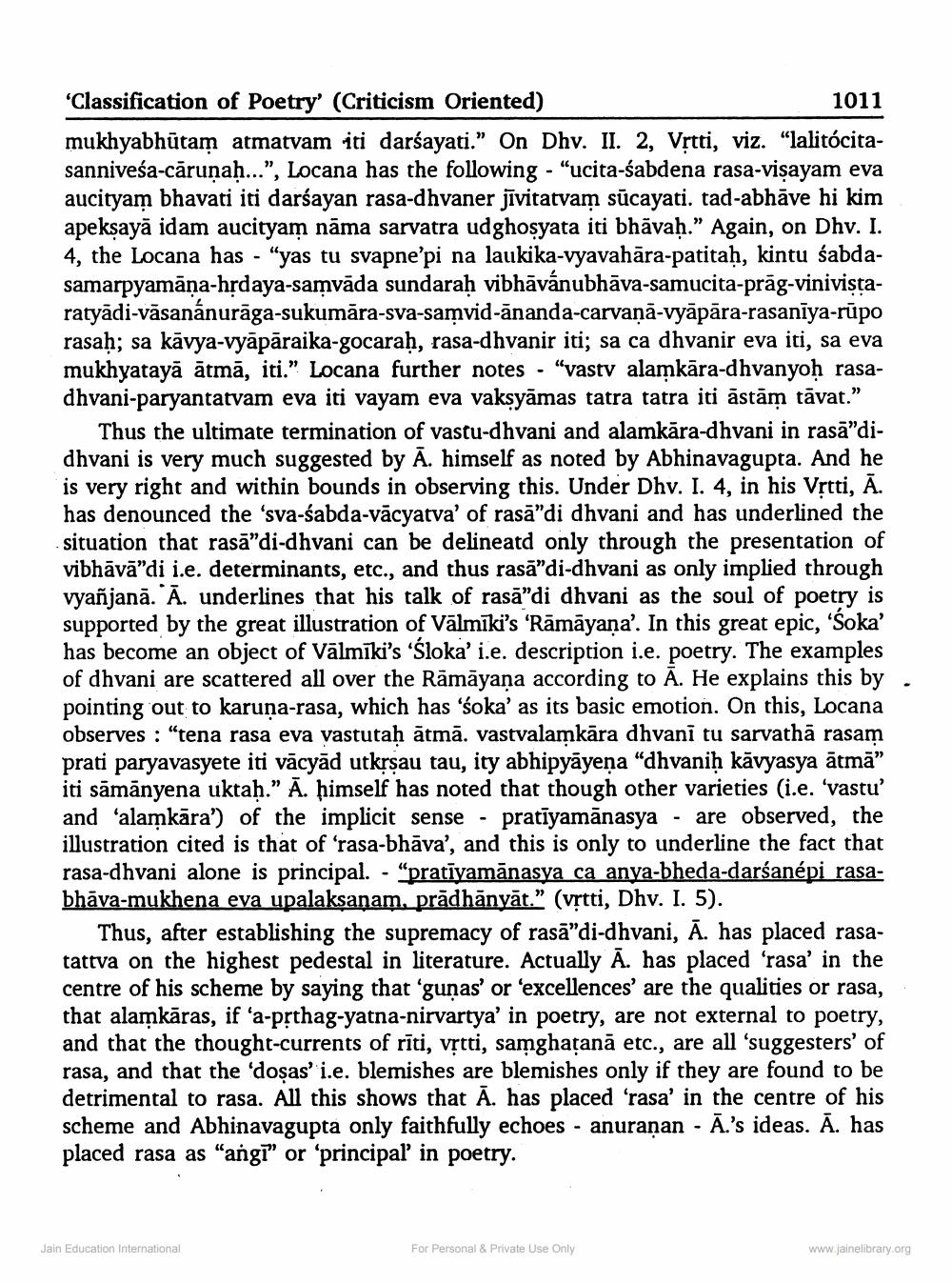________________
'Classification of Poetry (Criticism Oriented)
1011
mukhyabhūtam atmatvam iti darśayati." On Dhv. II. 2, Vrtti, viz. "lalitócitasanniveśa-cārunah...", Locana has the following - "ucita-śabdena rasa-visayam eva aucityam bhavati iti darśayan rasa-dhvaner jīvitatvam sūcayati. tad-abhāve hi kim apekṣayā idam aucityam nāma sarvatra udghosyata iti bhāvaḥ.” Again, on Dhv. I. 4, the Locana has - "yas tu svapne'pi na laukika-vyavahāra-patitah, kintu śabdasamarpyamāna-hrdaya-samvāda sundarah vibhāvānubhāva-samucita-prāg-vinivistaratyādi-vāsanánurāga-sukumāra-sva-samvid-ānanda-carvanā-vyāpāra-rasanīya-rūpo rasah; sa kāvya-vyāpāraika-gocarah, rasa-dhvanir iti; sa ca dhvanir eva iti, sa eva mukhyatayā ātmā, iti.” Locana further notes - "vastv alamkāra-dhvanyoḥ rasadhvani-paryantarvam eva iti vayam eva vaksyāmas tatra tatra iti āstām tāvat."
Thus the ultimate termination of vastu-dhvani and alamkāra-dhvani in rasa"didhvani is very much suggested by A. himself as noted by Abhinavagupta. And he is very right and within bounds in observing this. Under Dhy. I. 4, in his Vịtti, Ā. has denounced the 'sva-sabda-vācyatva' of rasa"di dhvani and has underlined the situation that rasā"di-dhvani can be delineatd only through the presentation of vibhāvā"di i.e. determinants, etc., and thus rasā"di-dhvani as only implied through vyañjanā. Ā. underlines that his talk of rasā"di dhvani as the soul of poetry is supported by the great illustration of Vālmīki's 'Rāmāyana'. In this great epic, 'Soka' has become an object of Vālmīki's 'śloka' i.e. description i.e. poetry. The examples of dhvani are scattered all over the Rāmāyaṇa according to Ā. He explains this by. pointing out to karuņa-rasa, which has 'śoka' as its basic emotion. On this, Locana observes : "tena rasa eva vastutaḥ ātmā. vastvalamkāra dhvanī tu sarvathā rasam prati paryavasyete iti vācyād utkrsau tau, ity abhipyāyeņa "dhvanih kavyasya ātmā” iti sāmānyena uktah.” Ā. himself has noted that though other varieties (i.e. 'vastu' and 'alamkāra') of the implicit sense - pratīyamānasya - are observed, the
lustration cited is that of 'rasa-bhāva', and this is only to underline the fact that rasa-dhvani alone is principal. - "pratīyamānasya ca anya-bheda-darśanépi rasabhāva-mukhena eva upalaksanam, prādhānyāt.” (vịtti, Dhv. I. 5).
Thus, after establishing the supremacy of rasā"di-dhvani, A. has placed rasatattva on the highest pedestal in literature. Actually Ā. has placed 'rasa' in the centre of his scheme by saying that 'gunas' or 'excellences' are the qualities or rasa, that alamkāras, if 'a-prthag-yatna-nirvartya' in poetry, are not external to poetry, and that the thought-currents of rīti, vrtti, samghatanā etc., are all 'suggesters' of rasa, and that the 'dosas' i.e. blemishes are blemishes only if they are found to be detrimental to rasa. All this shows that A. has placed 'rasa' in the centre of his scheme and Abhinavagupta only faithfully echoes - anuranan - A.'s ideas. A. has placed rasa as "angi" or 'principal in poetry.
Jain Education International
For Personal & Private Use Only
www.jainelibrary.org




